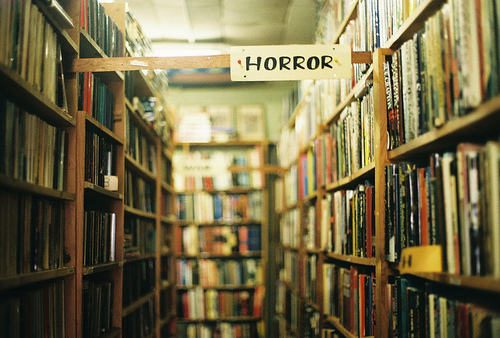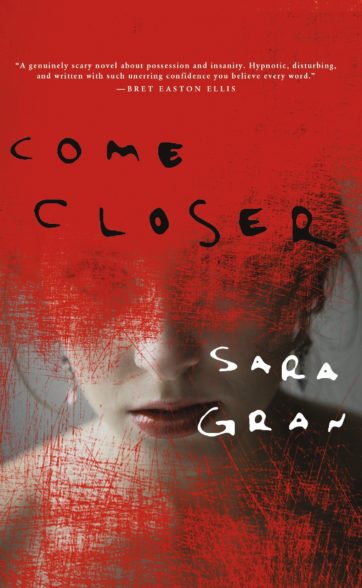 For years I’ve been advising genre fans to look beyond the horror racks for reading material, as plenty of the best fiction can be found elsewhere. It’s the only way, after all, you’ll be able to track down essentials like THE PAINTED BIRD, MALPERTUIS, FIGHT CLUB, THE KILLER INSIDE ME and many others.
For years I’ve been advising genre fans to look beyond the horror racks for reading material, as plenty of the best fiction can be found elsewhere. It’s the only way, after all, you’ll be able to track down essentials like THE PAINTED BIRD, MALPERTUIS, FIGHT CLUB, THE KILLER INSIDE ME and many others.
But having said that, a recent book and its reviewers have convinced me that we might just be better off with traditional horror fiction. Yes, lots of great horror fiction has been drafted by writers working outside the genre (or so they think), but sometimes it’s best to stick with those who know the territory.
The impetus for this essay is COME CLOSER, a highbrow horror novel by Sarah Gran that drew me in by virtue of the arresting back cover blurbs from the likes of Brett Easton Ellis (who dubs it “one of the most precise and graceful pieces of fiction I’ve read in some time”), Darin Strauss (“an intelligent horror story, a literary creepshow that works its magic subtly and well”), Kathryn Davis (“COME CLOSER left me profoundly disturbed…terrified and sleepless and unable to shake free of its horrible spell”) and George Pelecanos (“Author Sara Gran writes with scalpel-like clarity, expertly blending tones to create a new kind of psychological thriller”).
The book is indeed a pretty good one, a short (168 large-type pages), precise and admirably unpretentious tale of a hip NYC chick possessed by a demon. What it isn’t is terribly original, being a traditional account that doesn’t bring anything new to the age-old demonic possession subgenre. And yet the blurbmeisters mentioned above, and the publishing industry in general, insist on treating COME CLOSER like something novel and interesting—and to them I’m sure it is. Never mind that the sort of subtle, low-key horror of COME CLOSER has already been done, and far better, by authors like Ramsey Campbell, T.M. Wright, Dennis Etchison, Thomas Tessier and even Stephen King. But I strongly doubt Gran or those who so enthusiastically blurbed her novel have ever read any of those writers, all of whom write straight-up horror and make no apologies for it.
 Despite what they claim, most “respectable” authors appear to have at least a partial interest in the genre. Quite a few publishing hotshots have at least one horror novel–correction: one literary horror novel–tucked away in their bibliographies, be it John Updike (with THE WITCHES OF EASTWICK), Joyce Carol Oates (ZOMBIE), Philip Roth (THE BREAST), Kingsley Amis (THE GREEN MAN), James Gould Cozzens (CASTAWAY), Anthony Burgess (A CLOCKWORK ORANGE), Brian Moore (COLD HEAVEN), Brett Easton Ellis (AMERICAN PSYCHO), Paul Monette (NIGHTFALL), Doris Lessing (THE FIFTH CHILD), Cormac McCarthy (OUTER DARK) or Ian McEwan (THE CEMENT GARDEN).
Despite what they claim, most “respectable” authors appear to have at least a partial interest in the genre. Quite a few publishing hotshots have at least one horror novel–correction: one literary horror novel–tucked away in their bibliographies, be it John Updike (with THE WITCHES OF EASTWICK), Joyce Carol Oates (ZOMBIE), Philip Roth (THE BREAST), Kingsley Amis (THE GREEN MAN), James Gould Cozzens (CASTAWAY), Anthony Burgess (A CLOCKWORK ORANGE), Brian Moore (COLD HEAVEN), Brett Easton Ellis (AMERICAN PSYCHO), Paul Monette (NIGHTFALL), Doris Lessing (THE FIFTH CHILD), Cormac McCarthy (OUTER DARK) or Ian McEwan (THE CEMENT GARDEN).
Alas, not all such novels are successful. For every mainstream author who manages to craft an effective piece of horror fiction—Ben Hecht with FANTAZIUS MALLARE, Peter Ackroyd with HAWKSMOOR—there are quite a few who don’t. Paul Theroux tried his hand at a ghost story in 1974’s THE BLACK HOUSE, with absolutely mind-numbing results. In my view Valerie Martin’s insanely overpraised Jekyll and Hyde retelling MARY REILLY is a leaden effort fully befitting the shitty Julia Roberts movie adapted from it, while critics’ darling Rupert Thompson’s purported sex ‘n sleaze opus THE BOOK OF REVELATION shocked me only by how unshocking it actually is.
At least I made it through those books, though. I can’t say the same for other “thinking man’s horror stories” such as INCUBUS by Ann Arensberg, THE HOUSE NEXT DOOR by Anne Rivers Siddons or PICTURES AT AN EXHIBITION by D.M. Thomas.
Of course, COME CLOSER, the book under discussion, doesn’t fall into the above category, having been penned by a fairly new writer. It joins literary horror novels by first or second time writers, all of which come with effusive notices by many of the established authors mentioned above, like ORDINARY HORROR by David Searcy, THE BUTCHER BOY by Patrick McCabe, THE MUSEUM OF LOVE by Steve Wiener, THE AUCTIONEER by Joan Samson and THE COMPANY by Arabella Edge.
To be fair, most of those books are quite accomplished. Far less edifying are THE HOLE by Guy Burt, a limp variation on LORD OF THE FLIES; DESPERATE CHARACTERS by Paula Fox, an obnoxiously uneventful 1970 exercise in highbrow horror that was repackaged a couple years ago as a “modern classic”; FLYING TO NOWHERE by John Fuller, a “poetic” medieval-set exercise in sheer boredom; and something called THE SILENCE OF THE SIRENS by Adelina Garcia Morales, which supposedly “sings with insane magic” but is in actuality little more than an uninspired succession of worn-out TWILIGHT ZONE clichés.
I have no problem with literary authors writing horror fiction, or with publishers packaging their work as such. A non-horror writer can often bring a new energy to the genre free of the annoying conventions adhered to by traditional horror scribes (as I wrote of Kirsten Bakis’ LIVES OF THE MONSTER DOGS: “for once, the action isn’t slowed down by a gratuitous romance”). Literary horror masterworks like DAGON by Fred Chappell, HOUSE OF LEAVES by Mark Danielewski and MONTANA GOTHIC by Dirck Van Sickle are successful in large part because they so fearlessly twist and/or ignore outright any number of hidebound genre formulas. But those authors at least seemed to know the formulas they were tweaking. DAGON author Fred Chappell is evidently conversant in the works of H.P. Lovecraft, whose Cthulhu Mythos inform his novel, while Mark Danielewski well knows the genre conventions he so adroitly toys with in HOUSE OF LEAVES, as does Dirck Van Sickle the gothic mainstays addressed by MONTANA GOTHIC.
Sara Gran, on the other hand, doesn’t seem to realize the demonic possession premise of COME CLOSER is old hat. Likewise, it’s downright embarrassing the way Rupert Thompson carries on in THE BOOK OF REVELATION, pathetically unaware his book is anything but revelatory. Be it a newcomer like Gran or an experienced scribe like Thompson, these folks, as well as those who so enthusiastically review them, are plain ignorant when it comes to horror fiction, or for that matter popular fiction in general. Ann Arensberg, in an interview at the end of the paperback edition (a trade paperback edition, of course) of her insufferable literary horror fest INCUBUS, blithely admits she’s “never read Stephen King”. Too bad, as some knowledge of King’s fiction might have improved her own.
Perhaps Arensberg, Thompson, Gran and their likes would be better off sticking to what they write best: pretentious accounts of stuffy college professors reinvigorated by affairs with bohemian chicks, perhaps, or sentimental childhood memoirs. Should they attempt a horror novel, they’d do well to educate themselves in genre fiction, as should their reviewers. Until they do so I propose those of us who like to read this sort of fare take our business elsewhere.
For genre buffs, so-called literary horror has much value, but do keep in mind that, in the end, there’s nothing like the real thing.
